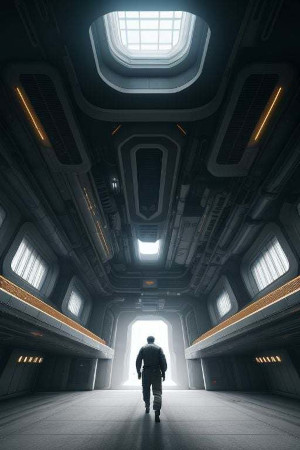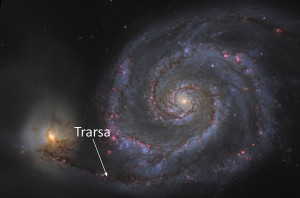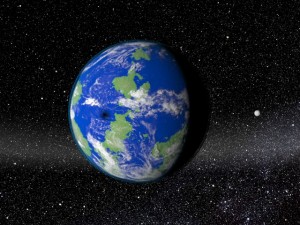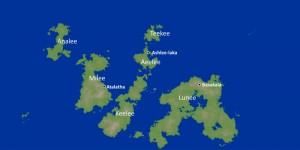2014
Sep
04
Trarsa: A Survey of an Advanced World
For 65,000 years, Trarsa was the dominant civilization in the known universe and the effective leader of the Triumvirate. As such, it was the center of intergalactic civilization for more than 60,000 years. Today, as the home of Nekalee and Ritee of A Hierarchy of Gods, who figure prominently in the history of the universe, Trarsa remains a planet of primary significance.
Physical features of Trarsa
Astrography
Trarsa is located near an active star-forming region in the tidal bridge between the two colliding galaxies known in Earth nomenclature as M51. It is impossible to identify the exact placement from Earth because we see the galaxies as they were 23 million years ago, and in the time between then and now, they have drifted further apart. The illustration here should be considered only an approximation.
Trarsa orbits a class F8-V star slightly hotter and more massive than Earth's. Its orbit is about 20% larger, but the greater stellar mass brings the length of the Trarsan year down to only 1.09 Earth years. The planet averages about 2°C warmer than Earth, but this is enough that Trarsa has minimal ice caps. The planetary inclination of only 0.5° leaves the world without noticeable seasons. The eccentricity of the orbit today is 0.005, and varies little throughout the eras.
The Trarsan day is shorter than ours, about 21.5 hours. Nekalee adapted to the longer day on Earth better than Ritee, which in part accounts for why Ritee was sleeping at odd times.
Moons
Trarsa is unusual for an Earth-like planet in that it has seven moons. All are smaller than Earth's moon, and the nearest is less than half as distant, but its angular diameter remains smaller at about 1/4°. Orbital periods range from about 12 Earth days to 183 Earth days. The nearest moon is the largest, but the most distant is fairly large too, and remains an obvious disk in the sky.
The inclination of the moons' orbits, like the inclination of Trarsa itself, is quite small, all of them less than a degree. This has two consequences to observers on the planet. For those living near the equator, solar eclipses are quite common. However, because the moons are significantly smaller than Earth's and the angular diameter of their star only slightly smaller than our sun, total eclipses are not possible. Therefore, all of the eclipses are partial. Figure 2 shows the shadow of one such eclipse.
The other consequence is that the inner five moons are always eclipsed by the planet when they are in opposition, so they are never seen full. The outer two moons, far enough out to escape the shadow of Trarsa, can appear full, but the sixth moon is so small that is just a spot in the sky like Jupiter from Earth. Early in Trarsani history, there was the notion of a month beginning on the date that the innermost moon emerged from eclipse, but as the period of that moon is only 12 days, it is comparable to a week as well. As the Trarsani developed, they abandoned that usage except as an item of historical curiosity.
Geography of Trarsa
Environment
Trarsa is smaller than Earth, having a surface gravity of about 0.8 of ours. There is relatively more water than on Earth, covering about 85% of the surface, and the continents tend to be narrow, running in a southwest to northeast direction having mountainous backbones. Being warmer and having a larger surface of water, the relative humidity is consistently higher and the precipitation greater and more regular. As a consequence, nearly all land area is covered in dense vegetation. The Trarsani concept of a desert is rather like Kansas.
The warmer temperatures and higher humidity content of the Trarsan atmosphere leads to more violent weather than is common on Earth. High winds exceeding 100 km/hr and deluginous rain are almost a daily experience. Clouds almost always mean a downpour, but forest occupants miss much of it because most of the water ends up funneled down the tree trunks. Such a large volume of water results in hundreds of fairly short but torrential rivers creating waterfalls that surpass all the records held by Earth. The forests, though are hardly affected, as the trees have suffered this weather for millions of years. The weather is one of the reasons that the Trarsani build their cities in the deep forests or on the leeward sides of mountain ranges, or underground.
Trarsa is more geologically active than Earth. Earthquakes are more common, but fault lines usually do not build up the degree of tension that they do on Earth, so they are rarely severe. Violent volcanic activity is virtually unknown, but on the geologic scale there has been a large amount of lava flow. This has resulted in relatively more basalt exposed at the surface, so basaltic columns are common. Combined with the extensive river system and its waterfalls make scenes similar to that in Figure 3 commonplace. Imagine, if you will, an entire planet that looks like Hawaii.
Flora and fauna
About 90% of Trarsa's land surface below alpine regions is covered with forest. Only the polar regions of Keelee and Lunee and high altitudes are without trees. Most of the trees resemble terrestrial cycads in that they are tall and straight with a lush fern-like head of leaves at the top. However, they differ from cycads in two important ways. First, they are flowering plants. Many have flowers one to two meters in diameter suspended from the canopy and fertilized by a variety of insects, most famously the lesso, which resemble a large cross between butterflies and dragonflies. Second, the trees are massive, typically reaching diameters of as much as 15 meters and heights of 300 meters, about the height of an 80-storey skyscraper.
The forest floors are an ecosystem unto themselves, dominated by chemoorganoheterotrophs. Fern-like plants similar to the Earth variety, and large horsetail-like plants resembling Earth's prehistoric calamitaceae are abundant, but there is a wide variety of plant life that in the past supported farming, and large woody grasses similar to bamboo. The “horsetails” and "bamboo" were once used as building materials.
There being no significant climatic difference throughout the year, trees never had to figure out whether to be deciduous or evergreen. In fact, there are very few life forms, either flora or fauna, whose life cycles are synchronized to the year. There are baby birds all year around. Diurnal cycles, of course, remain as with virtually all worlds.
The Trarsani
Biology
The Trarsani are the most neotenous Population-K race in the universe. On the outside, they appear almost exactly like human 10-year-olds, and unlike the Kyattoni, whose mixed signals consistently confound any human who attempts to recognize an age in one, the illusion is nearly perfect. You could throw a Trarsani adult into any fifth-grade class on Earth, and aside from almost certainly knowing more than the teacher, you would never suspect anything odd. The Trarsani have no facial hair, and aside from pubic hair, there is no increase in body hair with puberty.
On a mass basis, the Trarsani are about 35% stronger than humans. When Ritee and Nekalee were on Earth with its greater gravity, this just about balanced out and left them only slightly relatively more robust than Lesley. But at home, with lower gravity, they have a much greater strength reserve than humans. Most would think little of climbing 100 meters up a city tree.
The Trarsani are a forest species. The thick forest canopy blocks most of the light from reaching the ground. As such, they rarely experience direct exposure to their star; although they may climb to the treetops at night, many have never seen their star. As such, they universally possess light pigmentation, almost white-skinned and blond haired. Figure 4 shows typical and dark Trarsani hair color. Lighter hair reaches nearly white or silver. Ritee and Nekalee are typical to light. The square cross-section of Trarsani hair yields an iridescent effect in bright light. Eye color ranges from green to light purple, with blue being the most common. Sometimes the blue is a quite deep and striking.
The Trarsani have 23% more brain cells than humans. Most of that difference is in the cerebral cortex, and the remainder in certain regions of the limbic system. Not surprisingly, the Trarsani have a higher average I.Q. than humans, the mean being about 150 on the human scale. We should note that Lesley Kellerman's I.Q. is cataloged at 155, which places him more intelligent than the average Trarsani. Nekalee, for the record, weighs in at 210.
Civilization
As with all highly neotenous species, the Trarsani are non-competitive, meaning they are completely cooperative. As a consequence, they have no laws as we know them and never invented anything resembling money. The closest they have to laws are protocols, and there are no penalties for failure to follow them. They have no police, no armies, no financial industry, no wages or prices, and no crime.
Unlike the Kyattoni, who concentrate their population into large metropolitan centers, the Trarsani are distributed all over the planet. However, the world still looks virgin from orbit. Since ancient times, the Trarsani built communities in the trees, rather like the Ewoks of Star Wars fame. They still do, and thousands of tree cities dot the planet. Only now, they are made with modern meta-materials and not woody "horsetails" and "bamboo". Where there are no trees, the Trarsani have built entire cities underground, these developing for the most part after technology made it feasible. However, there is archaeological evidence of underground dwellers in ancient times.
Figure 5 shows some major features of Trarsa. Trarsa has no capital city, as they have no government as we know it. Furthermore, technology is now so advanced that almost all cooperative projects can be managed without regard to location.
Ashlee-Laka is the home of Nekalee and Ritee. It is a smaller tree city with a population of about 200,000, but also one of the oldest, having a verified history dating back to before Trarsa's space era, almost 140,000 years. Atalatha, with a population of about 10,000,000, is also an old tree city, but is significant because it is the location of Trarsa's space fleet. It is one of the few locations where the forest has been cleared for another purpose. Basakala is an intermediate-sized city of about 1,000,000, and is representative of new cities built almost entirely underground.
History
The earliest settlements have been unearthed on Milee, dating back some 150,000 years. The species spread rapidly, and over a period of several thousand years had migrated to Keelee, then gradually northward to Aeelee and Teekee. The violent weather of Trarsa delayed seafaring by centuries, and ancient migration was only possible because of the thousands of closely spaced islands linking these continents. The hundreds of miles of open sea connecting settled areas to Analee and Lunee effectively isolated them until technology advanced to the point of mechanised travel. At various points in history, ice bridges have connected the southern regions of Keelee and Lunee, but there is no evidence that early Trarsani ever made any attempts to cross them, and at any rate may not have been able to do so.
Air travel likewise was delayed, as flights more than a few hours could be lethal. Global air travel did not become practical until the development of advanced supersonic transport. The remote island areas were not settled until the Trarsani reached a level comparable to 21st century Earth, about 135,000 years ago.
Space travel started similarly as with humans, but in general, because of their higher average intelligence, technological development proceeded much more rapidly despite their much lower population. Effectively, every Trarsani is a scientist. Efficient fusion engines came about relatively sooner, and as of that time they became independent of the weather. It was only 50 years between the invention of fusion power and the first rudimentary warp drives, and at that time interstellar exploration commenced. The Trarsani, unlike humans, never had any interest in colonizing other worlds, though they were adept at exploring.
Armed with second-order unit field technology, it was Trarsa that discovered Kria-Ki and Kyatton, both having at the time first-order technology. Naturally, Trarsa became the dominant member of their affiliation, the Triumvirate. They remained the dominant member until the Dissolution approximately 75,000 years ago.
Relationships
The Trarsani, in general, are quite open and friendly. As with humans, children live with their parents until they find a mate, then establish their own households. However, unlike humans, they rarely move far away from their place of birth unless two from different locations become mates. Extended family relationships are important, but they do not recognize a need to discriminate family identity and therefore do not see a need for family names. They see nothing there to document.
The Trarsani are absolutely heterosexual and lifetime monogamous, the latter being a trait associated with the more developed limbic regions. Siblings are not quite as close as Kyattoni siblings, but still much more so than typical humans. A sibling's mate is considered a sibling as well. Although not typical, is also not a violation of privacy for a brother or sister to be present during lovemaking, and not a violation of monogamy for a sibling to "help" on rare occasions, as doing so does not affect the love relationship between a couple. Such is more of a tradition on Aeelee and Teekee than elsewhere.
Being a non-competitive species, the Trarsani have no concept of social stratification. Consequently, all relationships are equal. If there is any notion of a "senior" partner it is only from the standpoint of experience. Although they do have gender identity (maleness and femaleness beyond structural biology) there is little expression of it other than that females usually wear their hair longer. (This is a trend across Population-K species in general, and is not understood.) There are no gender roles and no gender-specific clothing.
Language
Modern Trarsani is a constructed language based primarily on the ancient languages of Milee and southern Keelee. More information about the structure of Trarsani is available here. Because of the difference in psychology, human words related to law, money, war, hatred, or related concepts are often non-translatable. The expression translated as “The Enemy” in A Hierarchy of Gods is not native Trarsani, but was coined by Ritee's translator. The native Trarsani is more like, “The ones who destroy life.”
Overall, the Trarsani are more like humans than the Kyattoni.
Challenge
The Trarsani have intergalactic travel and materialize most of their needs out of energy. What would you predict is the most common means of personal mechanized transport on Trarsa?
- Teleportation
- Bicycles
- Hover platforms
- Turbolifts




















Comments
There are no comments for this post.
You must be logged in to post a comment.